Liquid chromatography-mass spectrometry (LC-MS) of steroid hormone metabolites and its applications
- PMID: 20083198
- PMCID: PMC2894289
- DOI: 10.1016/j.jsbmb.2010.01.005
Liquid chromatography-mass spectrometry (LC-MS) of steroid hormone metabolites and its applications
Abstract
Advances in liquid chromatography-mass spectrometry (LC-MS) can be used to measure steroid hormone metabolites in vitro and in vivo. We find that LC-electrospray ionization (ESI)-MS using a LCQ ion trap mass spectrometer in the negative ion mode can be used to monitor the product profile that results from 5alpha-dihydrotestosterone (DHT)-17beta-glucuronide, DHT-17beta-sulfate, and tibolone-17beta-sulfate reduction catalyzed by human members of the aldo-keto reductase (AKR) 1C subfamily and assign kinetic constants to these reactions. We also developed a stable isotope dilution LC-electron capture atmospheric pressure chemical ionization (ECAPCI)-MS method for the quantitative analysis of estrone (E1) and its metabolites as pentafluorobenzyl (PFB) derivatives in human plasma in the attomole range. The limit of detection for E1-PFB was 740attomole on column. Separations can be performed using normal-phase LC because ionization takes place in the gas phase rather than in solution. This permits efficient separation of the regioisomeric 2- and 4-methoxy-E1. The method was validated for the simultaneous analysis of plasma E2 and its metabolites: 2-methoxy-E2, 4-methoxy-E2, 16alpha-hydroxy-E2, estrone (E1), 2-methoxy-E1, 4-methoxy-EI, and 16alpha-hydroxy-E1 from 5pg/mL to 2000pg/mL. Our LC-MS methods have sufficient sensitivity to detect steroid hormone levels in prostate and breast tumors and should aid their molecular diagnosis and treatment.
Copyright 2010 Elsevier Ltd. All rights reserved.
Figures
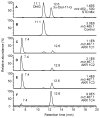
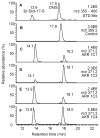
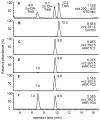

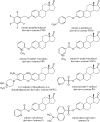
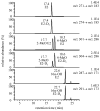
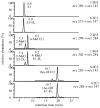
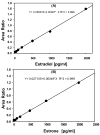
Similar articles
-
Androgen glucuronides analysis by liquid chromatography tandem-mass spectrometry: could it raise new perspectives in the diagnostic field of hormone-dependent malignancies?J Chromatogr B Analyt Technol Biomed Life Sci. 2013 Dec 1;940:24-34. doi: 10.1016/j.jchromb.2013.09.022. Epub 2013 Sep 27. J Chromatogr B Analyt Technol Biomed Life Sci. 2013. PMID: 24140653 Review.
-
Simultaneous quantitation of nine hydroxy-androgens and their conjugates in human serum by stable isotope dilution liquid chromatography electrospray ionization tandem mass spectrometry.J Steroid Biochem Mol Biol. 2017 Jan;165(Pt B):342-355. doi: 10.1016/j.jsbmb.2016.08.001. Epub 2016 Aug 12. J Steroid Biochem Mol Biol. 2017. PMID: 27531846 Free PMC article.
-
Targeted LC-MS/MS analysis of steroid glucuronides in human urine.J Steroid Biochem Mol Biol. 2021 Jan;205:105774. doi: 10.1016/j.jsbmb.2020.105774. Epub 2020 Oct 22. J Steroid Biochem Mol Biol. 2021. PMID: 33172831
-
Development, validation and application of a stable isotope dilution liquid chromatography electrospray ionization/selected reaction monitoring/mass spectrometry (SID-LC/ESI/SRM/MS) method for quantification of keto-androgens in human serum.J Steroid Biochem Mol Biol. 2013 Nov;138:281-9. doi: 10.1016/j.jsbmb.2013.06.014. Epub 2013 Jul 10. J Steroid Biochem Mol Biol. 2013. PMID: 23851165 Free PMC article. Clinical Trial.
-
Forced degradation and impurity profiling: recent trends in analytical perspectives.J Pharm Biomed Anal. 2013 Dec;86:11-35. doi: 10.1016/j.jpba.2013.07.013. Epub 2013 Jul 31. J Pharm Biomed Anal. 2013. PMID: 23969330 Review.
Cited by
-
19-hydroxy Steroids in the Aromatase Reaction: Review on Expression and Potential Functions.J Endocr Soc. 2021 Mar 23;5(7):bvab050. doi: 10.1210/jendso/bvab050. eCollection 2021 Jul 1. J Endocr Soc. 2021. PMID: 34095690 Free PMC article. Review.
-
Steroid profiling by gas chromatography-mass spectrometry and high performance liquid chromatography-mass spectrometry for adrenal diseases.Horm Cancer. 2011 Dec;2(6):324-32. doi: 10.1007/s12672-011-0099-x. Horm Cancer. 2011. PMID: 22170384 Free PMC article. Review.
-
A novel GC-MS method in urinary estrogen analysis from postmenopausal women with osteoporosis.J Lipid Res. 2011 Aug;52(8):1595-603. doi: 10.1194/jlr.D016113. Epub 2011 May 21. J Lipid Res. 2011. PMID: 21602563 Free PMC article.
-
Metabolism of androstenone, 17β-estradiol and dihydrotestosterone in primary cultured pig hepatocytes and the role of 3β-hydroxysteroid dehydrogenase in this process.PLoS One. 2015 Jan 15;10(1):e113194. doi: 10.1371/journal.pone.0113194. eCollection 2015. PLoS One. 2015. PMID: 25590624 Free PMC article.
-
What are the main considerations for bioanalysis of estrogens and androgens in plasma and serum samples from postmenopausal women?Bioanalysis. 2014;6(23):3073-5. doi: 10.4155/bio.14.277. Bioanalysis. 2014. PMID: 25529875 Free PMC article. No abstract available.
References
-
- Moal V, Mathieu E, Reynier P, Malthièry Y, Gallois Y. Low serum testosterone assayed by liquid chromatography-tandem mass spectrometry. Comparison with five immunoassay techniques. Clin Chim Acta. 2007;386(1–2):12–9. - PubMed
-
- Thienpont LM, Van Uytfanghe K, Blincko S, Ramsay CS, Xie H, Doss RC, Keevil BG, Owen LJ, Rockwood AL, Kushnir MM, Chun KY, Chandler DW, Field HP, Sluss PM. State-of-the-art of serum testosterone measurement by isotope dilution-liquid chromatography-tandem mass spectrometry. Clin Chem. 2008;54(8):1290–7. - PubMed
-
- Wang C, Catlin CH, Demers LM, Starcevic B, Swerdloff RS. Measurement of total serum testosterone in adult men: comparison of current laboratory methods versus liquid chromatography-tandem mass spectrometry. J Clin Endocrinol Metab. 2004;89(6):534–43. - PubMed
-
- Giese R. Measurement of endogenous estrogens: analytical challenges and recent advances. J Chromatogr A. 2003;1000(1–2):401–12. - PubMed
-
- Stanczyk F, Lee JS, Santen RJ. Standardization of steroid hormone assays: why, how and when? Cancer Epidemiology, Biomarkers & Prevention. 2007;16(9):1713–9. - PubMed
Publication types
MeSH terms
Substances
Grants and funding
LinkOut - more resources
Full Text Sources
Medical

